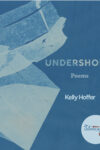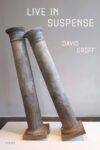Since last April, I’ve been waiting patiently for the surfacing of a particular text: the obituary of Dr Samuel Gruber, shark expert, born 14 May 1938, died 18 April 2019. The obituary is the literary form that I’ve been trawling through for a few decades now.
My enthusiasm for Gruber is also long-standing, dating from my discovery of an online chat session (dial-up AOL, anyone?) he held with school children in 1995, in which he conveyed his love for the lemon shark. Prompted by this, I looked more deeply into his fieldwork and academic history. In a back catalogue pushing two hundred papers, Gruber looks at the ecology and perceptual systems of sharks; particularly, their eyes.
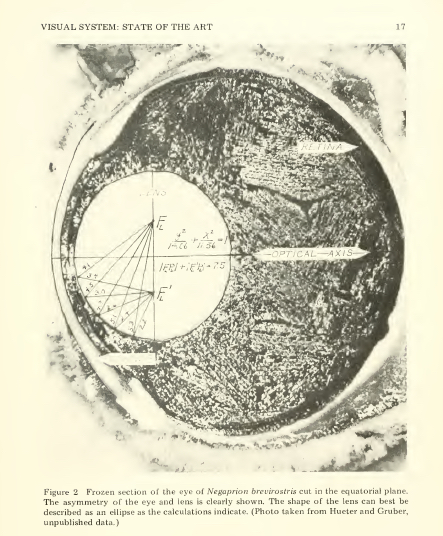
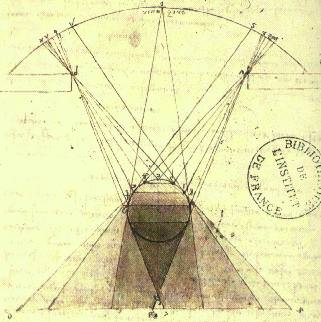
From 1963 onwards, Gruber’s papers have covered topics including photoreceptors, physiology of vision, conditioning of the nictitating membrane response, spectral sensitivity, retinal structures, and ganglion cells. There are some intriguing titles: ‘Development of a Contact Lens for Refracting Aquatic Animals’, 1983. (Shark science titling, and indeed the whole vocabulary, is a rich vein of poetry and allusion for the non-scientist.1)
To my mind, though, Gruber’s most important work is on the balance of rod and cone cells in a shark’s eye, which dictates how it apprehends colour and contrast, and on the shark’s flicker fusion rate, which informs its perception of light and motion. Creatures with more rod cells receive less visual input from the colour of their surrounds, but are better at perceiving tonal contrast and sudden movement; they can quickly see, for example, a pale shrimp darting from behind a dark rock. Sharks with a strip of colour-sensitive cone cells along the middle of the retina have more visual sensitivity along a central band of view; they’re built to watch what potential prey is coming and going along the horizon.
My appreciation of all this icthy-biology combined with a close reading of the book Jaws and its film adaptation (Peter Benchley, 1974, dir. Steven Spielberg, 1975) led me to this discovery: Because of the cellular structure and chemical processes within its retina, if we were to take a lemon shark to the cinema, its preferred viewing would be a technicolour movie, on wide-screen, of a film projected at double-speed – a laconic Clint Eastwood against wide desert horizons would work, perhaps – and the shark would want to attend the late show rather than a matinee, to give its eye longer to become dark-adjusted. (Citations available, on request.)
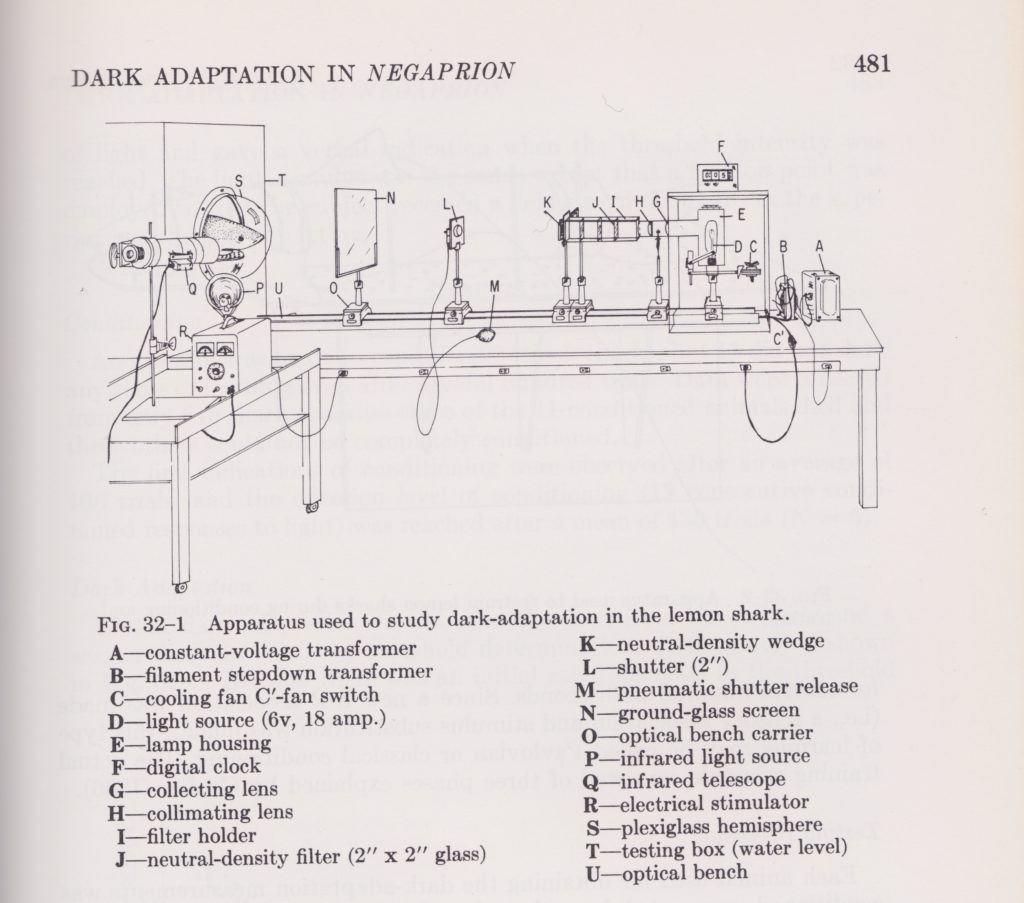
In addition to the bibliography, there are many other pleasing details in Gruber’s biography. Alongside a lifelong dedication to sharks, he had an enthusiasm for other fast vehicles, such as fancy sports cars and World War Two planes. These are not similar, you might protest: cars aren’t sharks. Well. They do, on investigation, share a space, and a quality. They lurk, just near the boundary, not clearly visible, and often containing bodies. And however much we fondly imagine that the shark will remain on its side of the water, and we humans in our vehicles will stay over here, beyond a boundary, there are many times when this separation does not hold. There’s a crossing, by means of the long, sleek vehicle, of the two zones. An engagement or entanglement with the surface.
Sometimes this is deliberate. The surfer on the board is one example of the human choosing to slide right over the surface, in parallel with the shark, usually not quite connecting. Sometimes it’s a mistake. The car is a vehicle that should stay land-side, but doesn’t. Take, for example, Ted Kennedy’s Oldsmobile 88, dragged out of the water at Chappaquiddick in 1969: a vehicle, the body of Mary Jo Kopechne, an uproar. Or take the children’s missing mother, underwater in her car, in The Night of the Hunter (dir. Charles Laughton, 1955). Or, closer to my home, take this downed plane, nicknamed the Maid of Harlech, in, or not quite in, the Welsh tides.
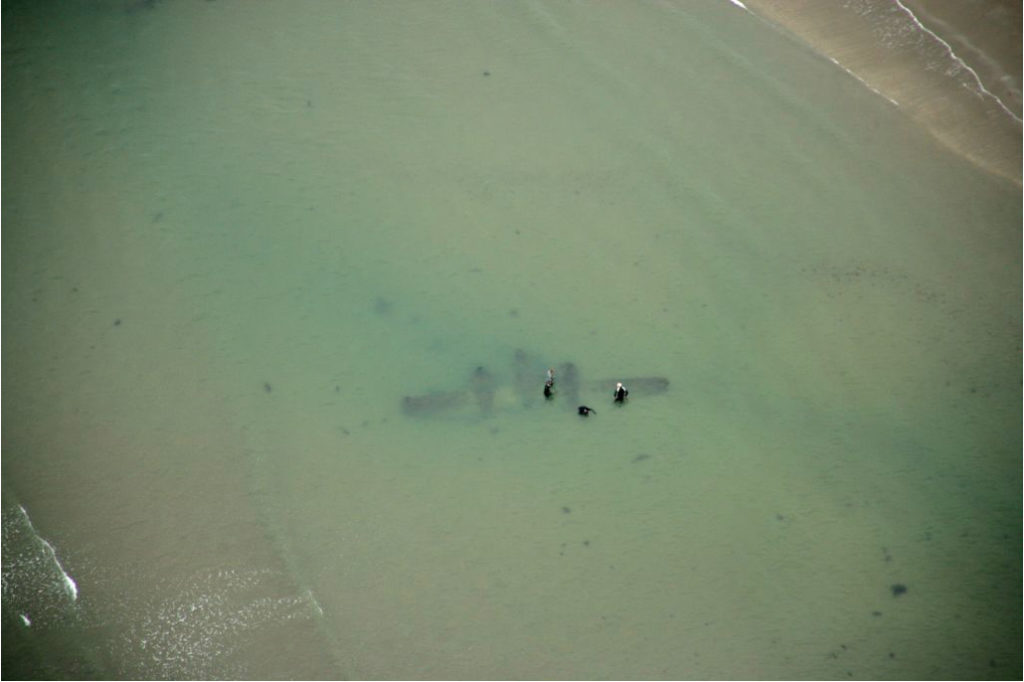

There’s a profusion, a tailback of vehicles near the water’s edge, in places and positions that cause trouble. The shark and the vehicle do get confused; there’s a sense of cross-over, interchangeability, between them. Think of Police Chief Brody carrying out his secret autopsy in Jaws the film, pulling car licence plates out of a shark – there’s something there to do with vehicles of death that he’s almost about to understand. Same for us: sometimes a vehicle under the water is hidden, sometimes it’s visible from airside. But even then, it’s not easy to understand properly.
The historian Alvin M Josephy (in The Indian Heritage of America, 1968) offers the term Ha yeak, which, in Tlingit, a language of the North-west Pacific coast, means “the hollow left in shallow water by a swiftly swimming shark”. An elegant, ominous concept, which is just about right for how I think of the object occupying the vehicle / shark space: there’s something there, just near the surface, that we can’t see directly. Ha yeak is a site of turbulence or interplay between absence and presence – a body was here and made a not-thing, a gap – and it’s a concept that summons the passage of time into the situation: we now see and understand the place where something no longer is. We read the shark’s proximity from the hollow; we know it was here, but it’s gone. But it’s still near, lurking; some things won’t go away.
A second aspect of Gruber’s work that I like is his involvement in activities of taxonomy and ordering, establishing archives and a corpus of knowledge. It might be an unfashionably Enlightenmental way of going about things, but I don’t mind this, and he does it with such obvious care for and engagement with his objects of study. As he says, he wants to understand the merkwelt of the shark, its perceptual niche. While we’re looking at words in translation, I’ll point out that this term comes from the German verb merken – to notice, realize, or, more faintly, to remember. Combined with Welt, the world. The perceptual world, but murky, submerged.2
In 1983 Gruber founded the American Elasmobranch Society, dedicated to study of the eponymous sharks, skates and rays – the cartilaginous fish, in contrast to the bony ones. The AES appears to be a welcoming, outward-looking body, but its name alone presents questions about parochialism, whether we might confine knowledge, or professional affiliation, or sharks, within the boundaries of geography or the nation state. I don’t think Gruber would have been unaware of these questions; when considering the sharks themselves, his more recent work looks at patrophily, at genetic relations between individual sharks and families, at their sociability and who they associate with. How they cavort.
And I like Gruber because he notices sharks swimming. Here’s his comment to the school children as transcribed in 1995:
PHEROMONES….Evidence comes primarily from aerial observations which I make in the shallow waters of Bimini Lagoon. During the reproductive period I often see formations of sharks that are separated by distances that preclude vision. For example, 4 or 5 sharks can follow each other in a circle that is 300 meters in diameter–and the circle is PERFECT!
He proposes an “odor corridor”, and says initial examination of urine hasn’t gone well; “I wish I could say more.”
So here’s Gruber, in his light aircraft, gliding above the beautiful Caribbean, watching lemon sharks as they dance below in a perfect circle. It sent me over to my bookshelves, reaching for Vasari’s Lives. (Originally, Le Vite de Piu Eccellenti Pittori […], or, channeling Keanu, The Lives of the Most Excellent Painters, Sculptors and Architects. I quote here from the more pedestrian 1908 abridged translation by E.L. Seeley, Stories of the Italian Artists from Vasari.)
Something about the sharks had reminded me of the Italian painter Giotto. Here he is, round the turn of the 14th Century, attracting the attention of Pope Benedict, who “sent one of his courtiers into Tuscany to see what sort of a man he [Giotto] was and what his works were like, for the Pope was planning to have some paintings made in S. Peter’s.” The courtier “asked him for a little drawing to send to his Holiness. Giotto, who was a man of courteous manners, immediately took a sheet of paper, and with a pen dipped in red, fixing his arm firmly against his side to make a compass of it, with a turn of his hand he made a circle so perfect that it was a marvel to see it.”
So I knew this already, that Giotto had a talent for circularity that marked him as an artistic genius. The parts of the story I didn’t know were the surrounds, or circumference: his prompt for making such a circle, and his response after. The courtier, “thinking he was being laughed at, asked, ‘Am I to have no other drawing than this?’ ‘This is enough and too much,’ replied Giotto, ‘send it with the others and see if it will be understood.’”
It – the drawing – was understood. Giotto was welcomed to Rome, and “there never left his hands work better finished.” But his comments, and the action itself, are strange. A painting of a red circle. Is he pre-Maleviching? But it’s not a painting of a circle, a representation; it’s a demonstration that he can paint circles; a show of skill. The form of the message is the content is the meaning. The meaning radiates outwards, from the circle.
Giotto’s circle is not quite a shibboleth, that is, a word whose pronunciation tells the listener whether the speaker is endogenous or an enemy.3 A shibboleth is not a code word, the knowledge and possession of which allow safe passage; instead, it is a linguistic site where personal origin is revealed: a word is spoken and heard – is this person using the ‘s’ that opens ‘circle’ or the ‘sh’ that starts ‘shark’? – and the sibilance, or lack thereof displays and betrays an affiliation.
Nor is Giotto’s action painting just a gesture, as in a war film where a disguised German soldier gives himself away in an English pub by the automatic motion of his thumb – to flip the round lid off his beer stein as he raises it to his lips – but here, there is no lid… And this is another case of the liquid’s surface being the place where we can see impending death, destruction, and alongside these, interpretation: the other drinkers, and the film viewers, can, in the froth at the top of the pint, read this gesture and respond to it.
No, Giotto’s circle is a mark of distinction. If they’re worthy of me, they’ll understand. He that has eyes to see, let him see – that sort of thing. Distinction, appreciation, connoisseurship – these lead down a whole historical and sociological avenue, flaneuring after Kant. The circle is a test and a token, a message and a demonstration, and a space, which creates the possibility for later art to appear. A holding pattern.
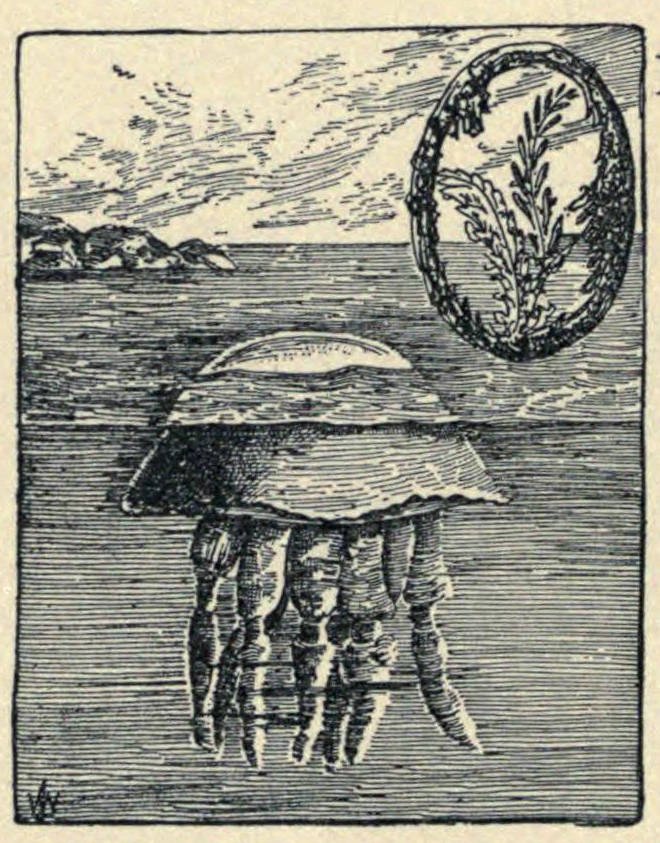
After Gruber’s death, and months of waiting, the obituary that I wanted finally swam into view. (It was on the website of the Save Our Seas Foundation. I’d have had it front and centre, every news outlet.) To circle back to a comment I made at the start, about my being an archivist of obituaries: I’m interested in the status of these written texts, that, though prompted and activated by death, are entirely about living. They appear, in the ideal, in the flimsy pages of a daily newspaper, but once printed, there’s a finality and solidity to them: this scrap of paper makes someone’s monument and memorial. Then, like a focusing lens, the obituary brings into balance and makes visible two scales of understanding, looking both at the personal qualities of the subject, and at their surroundings. Each obituary explains what field, what historical moment, the subject lived in, but also what they did to that environment: the obituary is a site of turbulence between the self and the world.
I like the contrast between this fixed literary format, with its rules and conventions, and the boundless range of lives and experiences that can be contained therein. All of the details. In Gruber’s case, I’m interested in his perfect circles: the swimming sharks, the globe of the shark’s eyeball. Or, further back within his discipline, there’s the circle of the shark’s jaws. And there is the fisherman’s legend that if a shark brushes against you and appears to swim away – don’t relax. The shark is only leaving to circle round, perfect and marvellously, before coming back to take its bite. It will return.

Sharks, and the circles they draw for us, serve as a model. They perform, illustrate, and exemplify, the space of waiting for something inevitable, something which comes with its own literary form. It’s true that a circle (or, death) is a boundary, a confine, a sort of constraint, if you’re inside it. But each circle, wherever we find it, is also an opportunity; it’s the blank zone which will, like Giotto’s, create a space to make art, if it’s understood in the right way. Time and distance might be required for the circle to work, as in the case of the Ha yeak, where the shark has to have already gone in order for the space to appear. Time might bring sharp-toothed catastrophe.
But here is where the freedom lies: in the circling portion of time, what is it that we’re going to choose to do, what might we observe, depict, dissect, or create? I’ll stop here. Like Gruber, I wish I could say more. But, with Giotto, this is probably enough and too much.
Melissa McCarthy is the author of “Sharks, Death, Surfers: An Illustrated Companion” (Sternberg Press, 2019). More at http://sharksillustrated.org
Notes
- Gruber also has the 1981 ‘Lemon Sharks: Supply-Side Economists of the Sea’, while with other authors we can range from Otway and Ellis’s 2009 ‘A Womb with a Different View’, on artificial perspex uteri for grey nurse sharks; to Demski and Northcutt’s 1994 paper, ‘Gross Brain Development in the White Shark: A Disappointment?’ Never to us.
- Tip: “It is not always convenient, but very murky or turbid water of limited underwater visibility should be avoided if possible. In any event, a particularly watchful eye should be maintained for shadows and movements in the water.” – ‘Advice to Swimmers, Divers, and Victims’ from Shark Attack, H. David Baldridge, (1974)
- Its literal meaning is ‘head of grain’, and it comes from an Old Testament episode, Judges 12:6, of testing each Ephraimite: “he could not frame to pronounce it right. Then they took him, and slew him.”
Image Sources
- Visual System of the Elasmobranchs: State of the Art 1960-1975
Samuel H. Gruber and Joel L. Cohen
Sensory Biology of Sharks, Skates, and Rays
Eds. Edward S. Hodgson, Robert F. Mathewson, 1978
OFFICE OF NAVAL RESEARCH
DEPARTMENT OF THE NAVY
Arlington, Va. - Ms2185;folio16-recto
Etude sur la réflexion de la lumière
Of the Codex Ashburnham, in the Bibliotheque de l’Institute de France
Their link, with specific warnings not to use, is at: https://www.photo.rmn.fr/archive/19-540148-2C6NU0AHILGK5.html
This (paler) digital image from https://www.wikiart.org/en/leonardo-da- vinci/study-of-the-graduations-of-shadows-on-spheres -
A Behavioral Measurement of Dark Adaptation in the Lemon Shark, Negaprion Brevirostris
S.H. Gruber
Sharks, Skate, and Rays
Ed P. W. Gilbert, R. F. Mathewson, D. P. Rall
The Johns Hopkins Press, Baltimore, Maryland, 1967 -
From this page: https://coflein.gov.uk/en/archive/645603/details/504
Royal Commission on the Ancient and Historic Monuments of Wales,
photographer T. Driver, 2007.
Image Reference AP_2007_3624
Taken from https://www.theguardian.com/uk-news/2019/nov/12/ww2-wreck-of-fighter-plane-off-welsh-coast-gets-protected-status
credit: Joseph Mearman/SCSEE/Bangor University -
P58 of Charles Holder
Charles Darwin: his life and work.
New York Putnam 1891
https://www.biodiversitylibrary.org/bibliography/21642 -
Ulisse Aldrovandi, 1613, De piscibus libri V, et de cetis liber I,
Digitized by Hathi Trust, originally from collection of Universidad Complutense de Madrid.
at this website: https://babel.hathitrust.org/cgi/pt?id=ucm.5319455282&view=1up&seq=394
This post may contain affiliate links.





